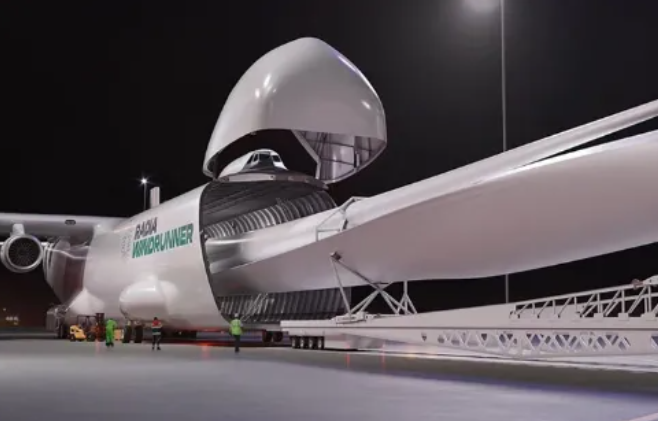The new aircraft is expected to transport 105-meter-long wind turbine blades to expand the reach of wind energy and meet global climate goals.
Three aerospace companies – Aernnova (Alvada, Spain), Leonardo (Rome, Italy) and AFuzion (New York, NY, USA) – are working with energy company Radia (Boulder, CO, USA) to develop the 365 foot WindRunner aircraft, which is being developed to transport some of the largest and most efficient wind turbine blades. The partners believe the aircraft will expand the reach of wind energy and enable the world to meet its climate goals.
Aernnova will develop the aircraft’s wings and engine mounts, while Leonardo will develop the fuselage. Both have extensive experience in composites.AFuzion will provide safety and certification consulting. Radia is reportedly targeting a 2027 entry into service (EIS-entry into service). The partnership agreement is the latest development in the WindRunner, an aircraft designed to transport wind turbine blades up to 105 meters long – and larger blades in the future, which Radia calls GigaWind – directly to wind farms, landing them on a surface as little as 1,000 feet long. farms, landing on a semi-ready dirt runway just 1,800 meters in length. The partners explain that it will overcome the logistical hurdles that currently prevent the expansion of onshore wind energy. The larger the wind blade, the more efficient it is, but long wind blades are difficult and costly to move via ground transportation due to bridges, tunnels and road curves.

The result will be the widespread availability of consistent, least-cost clean energy at more locations and industrial scales for the grid, green fuel production including SAF-sustainable aviation fuel, and commercial power users such as data centers and superscalers. The onshore wind energy market is estimated to be as high as $10 trillion by 2050 – with as many as 1 million wind turbines in operation!
As reported by Omar Memon in a March 2024 Simple Flights article, the WindRunner’s fuselage length (108 m³) is longer than any other aircraft in history, and can accommodate not only today’s typical 70-meter-long blades, but also future GigaWind blades up to 105 meters long. Its 8,200 m³ payload capacity dwarfs the 1,160 m³ and 610 m³ capacities of the Antonov An-124 and Boeing 747-400, and it is expected that its cargo hold will be seven times larger than the Antonov An-124.
The WindRunner’s maximum payload weight is 72.575 tons.Simple Flying reports that the Radia will rely on efficient aerospace-grade materials, approved manufacturing processes, and proven technologies to meet its aggressive 2027 EIS, noting that mass production of the aircraft will be based on infrastructure similar to that available for larger aircraft.
Radia CEO Mark Lundstrom said, “WindRunner is an opportunity for the aerospace industry to make a decisive impact on climate change, move to the energy sector and capitalize on a huge market opportunity.”
Vance Hilderman, CEO of AFuzion, added, “WindRunner must operate safely in a variety of operating environments.” . “The urgency of the climate crisis requires it to systematically complete the certification process in order to be put into service, and AFuzion is eager to leverage our capabilities to support the WindRunner’s progress from design to deployment.”






